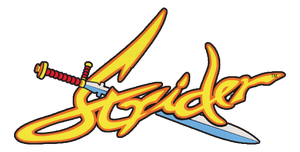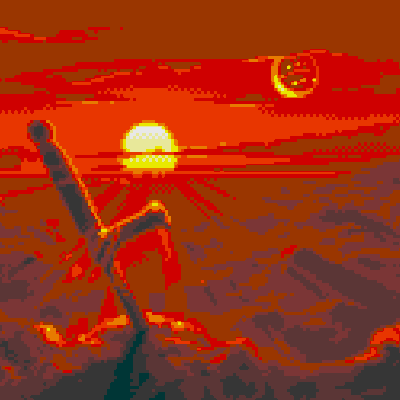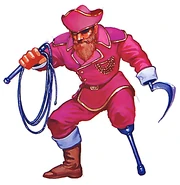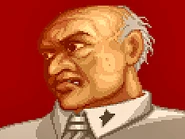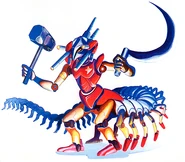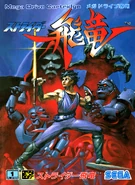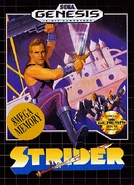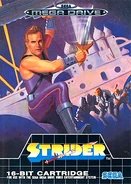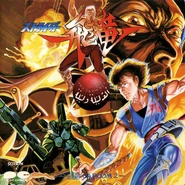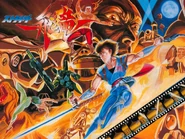Strider, known in Japan as Strider Hiryû (ストライダー飛竜, Sutoraidā Hiryû), is a 2D side-scrolling action platform game released on March 7, 1989, released by Capcom for their CPS-1 arcade board system and the first game in the Strider franchise. Set in an futuristic setting, the player assumes the role of Hiryu, an agent of the secret freelance ninja-like mercenary organization known as "Striders", through five expansive stages, overcoming obstacles and eliminating hordes of enemies to reach each stage's end boss. Strider was generally well received by critics and fans alike and is fondly remembered for its innovative gameplay, high quality graphics, memorable soundtrack and multilingual voice clips during cutscenes (presented in Japanese, Mandarin, Russian, Spanish and English).

Strider (Sega Genesis) - Stage One
Strider Arcade Gameplay.
Outside of its achivements, Strider (and its protagonist) is most known for being part of and jointly owned by a three-pronged collaboration between Capcom and artist group Moto Kikaku; consisting of this arcade game, a Strider Hiryu manga created by said artist group and published by Kadokawa Shôten, and a game developed for the Nintendo Entertainment System, all sharing the same name. After its original arcade release, the game was ported to virtually every known home system due to its popularity.
Gameplay[]
Strider has a simple layout: an eight-way joystick and two buttons, one each for attacking and jumping. The player has total freedom of movement, being able to jump in any angle and direction. Hiryu is very quick and easy to handle. By holding a direction before jumping, the player triggers cartwheel jumps to leap farther and move faster. Hiryu's most recognizable feature, however, is his ability to stick to any surface, using a sickle to cling onto walls and ceilings. The player can cling to any surface and freely move along its length; pressing up while clinging below a platform will flip Hiryu up onto its top.
Hiryu's health is represented as a three-unit lifebar positioned at the top left of the screen. Each unit absorbs one instance of damage. The player's number of lives and score are marked below and above the lifebar, respectively. A clock in the top center of the screen shows the time remaining for the player to complete the current section of the stage. Each stage has certain checkpoint areas where the timer resets and where the player respawns after losing a life.
Hiryu's primary way to attack is his Cypher, a sword-like weapon that, when swung, creates a plasma energy wave which damages on contact. The player can attack from any position (crouching, jumping, while clinging off ceilings or walls), as well as continuously by rapidly pressing the attack button.
Hiryu's other abilities include:
- Slide - By holding the stick down and pressing jump, the player can make Hiryu perform a quick sliding attack. This will eliminate enemies as well as going under certain hazards like projectiles.
- Cartwheel Jump[1] - By moving left or right and the Jump button, the player makes Hiryu perform a higher and longer jump that sends him flying forward, as he turns his body like a wheel.
- Acceleration Jump - So named in the NES Strider. When Hiryu runs down an inclined slope, he speeds up. By taking advantage of this acceleration, the player can jump farther than normal. This event is used sparingly; the most memorable time being during the downhill "Big Run" section of Siberia.
Several items can be found in each stage hidden within special item containers which are lying around or carried by flying enemies. Enemies do not leave items after being destroyed, and not all containers hold items: these will instead grant either 200 or 400 points after being opened.
One of this game's unique features is the use of helper robots, described above as Options. The Options serve as support for Hiryu by attacking any approaching enemy. There are three types of Options: Option A (Dipodal Saucer), a small bipedal robot which moves around Hiryu and attacks with ring-shaped lasers; Option B (Terapodal Robo-Panther), a Saber toothed tiger-shaped robot which remains at Hiryu's side and lunges at approaching enemies; and Option C (Robot Hawk), which circles the air above Hiryu and dives down to destroy airborne enemies. Except for Option C, the Options are connected with one of Hiryu's life units, recognized by it changing from green to yellow, and are destroyed if said life unit is lost.
Story[]
In the year 2048, also known as "Meio Year One" (冥王暦元年, Meiō-reki Gan'nen)[2], the world is ruled by a mysterious outerworldly being known as Grandmaster Meio, who holds control of all technology and military on Earth and has created his personal base on an artifical satellite known as The Third Moon. Meanwhile, the oppressive regime of the Kazakh administration, themselves servants of Meio, has led to the creation of rebel forces, who clash with government troops in conflicts all over the world.
Eventually, these rebel forces sought out the services of a clandestine group known as the Striders, who were experts of espionage and assassination. The dangerous and most important mission, to eliminate Grandmaster Meio, is given to their youngest and most talented Special A-Class member, Hiryu. With the destiny of humanity in his hands, Hiryu makes his move and infiltrates Russia's Imperial Capital and center of Meio's power, Kazakh SSR.
Characters[]
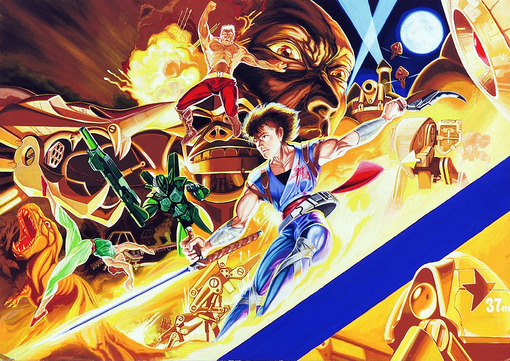
Promotional art.
- Captain Beard Jr. - Beard Jr. is the pirate-styled captain of the Flying Battleship Balrog. Once allied with the Earth forces, he changed sides after a confrontation with Grandmaster Meio cost him his limbs and one eye. Once Hiryu causes the collapse of the Balrog, Beard fights to the death as he attempts to escape using his hooked hand and his long-reaching whip.
- Ouroboros - A boss created by the merging of Kazakh's 24 officers into a serpent or centipede-like composite creature wielding Russia's sickle and hammer. He's fought at the end of the first stage and destroyed by Hiryu.
Development[]
Strider started life as part of a three-pronged collaboration between Capcom and the Japanese artist circle Moto Kikaku (also known as Motomiya Kikaku), consisting of this arcade game, a Strider Hiryu manga (with a different plot), and a game for the NES (with a plot loosly based on the manga), all sharing the same name.[3] The idea of working on a project with a company outside the world of gaming came from Akio Sakai, who back then recently joined Capcom as new head of development.[4][5][6] Sakai was able to secure the deal with Moto Kikaku, seeing it as a test to running a seralized manga and game at the same time.[4]
Development for the arcade game befell Capcom's "First Planning Room", one of the three development division at the time, lead by Tokuro Fujiwara.[7] After initial meetings, the core group for the project was quickly decided. Tatsumi Wada from Moto Kikaku was put in charge of the manga; the "consumer version" was given to Masahiko Kurokawa; and Tokuro Fujiwara handed the coin-op over to the background artist from Ghouls 'n Ghosts and Bionic Commando, Kouichi Yotsui, choosing him partly due to his experience with the CPS-1 arcade board[6] and because Fujiwara felt Yotsui had "really good negotiation skills."[5]
Collaboration[]
In order to iron out the project's setting and world view, the CEO of Capcom, Kenzou Tsujimoto, paid for the three men to stay at the Shinjuku Hilton hotel, along with a fourth, unnamed marketing executive from Capcom.[4] The three project leads laid out the outline of the story as if it were a manga and focused primarily on the main character; at first difficult, once they settled on a ninja protagonist, the way he would move and the kind of game that'd suit such a character came easily.[6] Because they were developing an action game, Yotsui pushed hard for a futuristic ninja concept, drawing equal inspiration from both the Shinjuku skyline outside their hotel windows and ninja TV series from the 1960's. At one point, he found himself locked onto the Hilton's rooftop. He climbed down the side of the building to the fire escape, "desperately afraid" that he would "die from the fall", though he also couldn't stop thinking about the game, concluding that "anybody that wanted to do that kind of thing must be crazy".[5]
During the course of a week, they worked out all three projects' common thread: the year 2048, Kazakh as the initial location, and Hiryu as the main hero.[4][5] Afterward, Wada returned to Motomiya Kikaku. Yotsui and Kurokawa returned to Capcom's headquarters in Osaka, working together to flesh out the rough outline all had agreed upon in Shinjuku.[4] The trio took advantage of Yotsui and Kurokawa's background in film as well: having both went to the same university and graduated in film, they were into "plots and stories" and were able to write out a scenario, coming up with several ideas for settings and creating all sort of details.[5][6] Yotsui, however, decided to only utilize the details that would "convey the atmosphere" he wanted players to feel, while leaving the rest to their imagination.[6]
They created Hiryu's design and sent it to Motomiya Kikaku in Chiba along with a few draft chapters.[4] Even though the basic idea was in place, Yotsui and Kurokawa still travelled constantly between the Capcom and Moto Kikaku offices, meeting with Wada and discussing new ideas over dinner. Although the three not always agreed on their opinions, their continued exchange allowed them to build the world of Strider more effectively.[5]
Isuke's Strider[]
Each team was supposed to take this fully-formed idea and adapt it to their assigned media.[3] Despite this initial intent, however, Kurokawa and Wada's ideas wound up overlapping considerably. They developed an involved storyline that became the backbone of both the manga and the consumer version being produced for the Famicom.[4] They wanted Yotsui to follow their ideas, but Yotsui viewed it as a competition to see who could make the best game.[3] In particular, Yotsui wanted to take the Ghosts 'n Goblins gameplay "to the next level", wondering how far he could take an action game "with one lever and two buttons". He felt it would be "impossible" to tell a complex story in an arcade game, as it would "destroy the gameplay".[4] He wanted to make "an adventure that stimulates the senses", and imagined the player "running, running, running to freedom". He believed that this type of game would best suit the coin-operated arcade format, not a plot-intensive storyline.[4]
Yotsui also felt that each project should heighten the Strider world through the methods each platform excelled at. Though he wanted to represent the same enjoyment provided by the manga's story, he considered trying to tell the story literally would compare his game unfavorably with his project brethren; so he instead decided to use the arcade's raw power to describe the action through visual imagery, thinking that would "turn the table" on his favor.[5] Thus, the coin-op strayed somewhat from the original outline and built its own story.
Strider started development as the third game in Capcom's then-new CP System arcade board, alongside Ghosts n' Ghouls and Forgotten Worlds.[4] Before that, Capcom's arcade games were done on custom hardware tailored to the project's needs, thus resulting in underpowered boards that were just enough to run character sprites at 16x16 pixels. The CP System allowed Isuke and his team to create characters at twice that size (32x32 pixels), making them "seem very large" in comparison,[6] a fact which was often praised about the game. Initially Hiryu's sprite was even bigger, but since the other artists made enemy sprites smaller, Hiryu had to be adjusted so as to not stand out too much.[8]
While creating the game, Yotsui tried to design it in such a way as to appeal to arcade gamers and "extract their money", noting that the onscreen action had to impress not only the player, but also the ones standing behind them, watching them play.[6] To achieve this, Yotsui felt he needed to show a new location with each stage and a constant stream of new ideas. He considered the second stage specially important, because it showed that the game would be constantly changing and this would incite players to see what'd come next. He also sought to subvert player's expectations, for instance by having a huge boss (Mecha Pon) at the beginning of the stage instead of at the end.[6]
Despite its initial development plan of eight months, Strider suffered from several delays due to Isuke demanding perfection from his staff,[5][6] with internal rumors that these delays would inversely affect sales.[3] In spite of this and Isuke's young age, he was shown a surprisingly amount of leniency from Fujiwara, giving him free rein and ensuring that Strider would "only be finished once [Isuke] said so".[5] The results, however, always felt short of what he envisioned. Isuke felt frustrated most of the time because he wanted to do much better, but the technology at hand wasn't able to keep up with his ambitions.[6]
Strider was initially scheduled to release in December 1988[9][10], but Isuke's filmic tendencies and drive for perfection caused the game to overshoot its budget and miss the date, eventually being released in March 1989 instead.[6]
Promotion[]
Strider was first revealed to the public during the 1988 Tokyo JAMMA AM Show held in September. Both Japanese[11] and Western magazines covered the game at the event, the latter under the initial localized title of "Falcon".[12][13] The event formally introduced the initial 2 stages and the Amazon stage, here listed as the 3rd stage. Although early reports stated the game would feature a stage selection system for the 3rd and 4th stage,[9] this was seemingly dropped by the time of this presentation.[11] Notably, the batch of screenshots released at the time, based on an earlier build of the game, would be reused years after in previews of an PC-Engine port.
Strider was first unveiled to the European audience during the London ATEI (Amusement Trades Exhibition International) event held at the beginning of 1989, now under its final title.[14] Yotsui also stated that he attended a location test held in California at one point, where he drew the final English logo.[4]
Following its delay, Strider was not seen in Japan until the February 1989 AOU Show, where the Flying Battleship Balrog was first introduced.[15] During the event, attendees were able to play the initial two stages in prototype arcade cabinets set at the location.
Influences[]
In creating the coin-op, Kouichi Yotsui drew inspiration from several sources. The multiple layers in Namco's Rolling Thunder suggested level design, and the helper characters in R-Type gave rise to the Option A's. Shirato Sanpei's Kamui Gaiden, whose ninja hero was accompanied by animal characters, suggested Option B and C.[4] Gameplay and level design, as well as Hiryu's agility and high acrobatics, were inspired not only from the roof incident described above, but also from Isuke's own love of mountain-climbing, skiing and diving.[5]
The non-player characters were also inspired by a variety of sources. The minor foes were originally intended to wear clothes, but most of these ended up getting cut from the final product, the Rascal's fur hat being the only remain left in-game. Most side characters like Tong Pooh, Solo and Captain Beard Jr. were introduced because Yotsui wanted to "show characters that didn't have a direct relationship with Strider or the Grand Master", in much the same way that Star Wars character Darth Vader's hiring bounty hunters in The Empire Strikes Back had. Yotsui felt this would "broaden the scope" of the game's world.[4] The large end-of-level bosses were inspired directly by Hiryu's nimble movements and climbing ability, feeling that "it made sense" having large enemies for the hero to face, and that enemies that took up half of the screen were perfect for an action game. He felt however they ended up being way too easy.[6]
Several varied real-life sources inspired the individual characters: Tong Pooh was inspired by Bruce Lee and the "Kung Fu Boom" of the time and named after a song from side two of Yellow Magic Orchestra's eponymous album, the boss Mecha Pon was an homage to Toho's Mechani-Kong; Grandmaster Meio was inspired by an image of Sauron, the Dark Lord of J.R.R. Tolkien's Lord of the Rings; and Lago was a bizarre pastiche containing the basic shape of a dinosaur, the clawing mannerisms of a chicken, and a head based off "the front of an F-16 fighter".[5]
World Setting[]
The use of a communist background was not influenced by the politics of the time, but simply because Isuke desired an unique setting that hasn't been in common use like America or Japan were. He describes his decision to use Russia and "Middle Eastern-style Mosques" as him being "immature" and "riding on the waves" of the [Cold War] times.[4] He also considered that part of the world "fresh" and "mysterious".[6]
To further enhance this feeling of a fully-formed world, Yotsui took the unusual step of reaching outside of his development team. Yotsui wanted "Strider to be able to run around an immense world that was filled with marvels", desiring "a really exotic mood", so he added short cinema scenes between stages to advance the story.[5] To voice the characters, Yotsui utilized the talents of a Capcom employee who had graduated from a "language academy" and a few of his friends. Their combined talents enabled the characters to speak in five different languages: Japanese for Hiryu, English for the Grandmaster and Solo, Mandarin Chinese for Ton Pooh, Russian for General Mikiel and Spanish for Captain Beard Jr. A sixth language, Swahili, was considered for the Amazon Tribeswomen, but Capcom objected against it on the grounds that portraying someone as primitive looked like discrimination.[3]
Music[]
The original arcade game soundtrack was composed entirely by female video game music composer Junko Tamiya, who was not credited for her work in the arcade version but was mentioned as part of the original arcade staff and as the original composer in some console adaptations and game soundtrack compilations[16] released afterwards.
Strider contains many different styles of incidental music themes that change dynamically throughout the game according to the stages and the situations on screen. These range from experimental and progressive futuristic sci-fi action themes to baroque, tribal and classical music pieces. Elements from the soundtrack have also been used in other Capcom games where Hiryu has appeared. These include the Marvel vs. Capcom series as well as other Strider related games.
Early revisions of the arcade game were missing the unique music for the Aerial Battleship and Third Moon stages. In this version the music from the first stage of the game was repeated here instead.
According to Tamiya herself, she relied on FM sound sources for producing each of the songs for the Strider arcade soundtrack.[17] Tamiya was told by the game's planners and the main designer that due to the non-stop action of the title and the several colorful scenarios there would be an emphasis on emotions and feelings, so she composed the tracks with that in mind.[16][17]
Before starting to work, she was also given Yotsui's direct instruction to study Igor Stravinski's "The Rite of Spring".[5][16] Isuke made her listen to the song over and over again while rejecting her initial works as he wanted the music to be perfect, and made a lot of demands to the sound staff, desiring the themes to be dramatic but also full of energy.[5] Tamiya couldn't stand hearing that song every day, describing it as being way too quiet and scary.[16] Eventually, however, she started to understand what Yotsui liked and didn't liked and made pieces he had no problems with.[5]
Afterwards, Tamiya was detailed about the game image that the planner was strongly pushing for. Creating music to complement that image took quite some time. That’s what led her to compose the unique main theme and the distinctive varied rhythms of each stage. Once this framework was established, Tamiya made the music as she liked and saw fit.[17] She recollects being specially excited to do a theme with African-like percussion instruments, being in a high mood when she composed it and enjoying its disjointed sequence.[16]
Isuke's stated inspiration for the music came from classic ballet and Walt Disney cartoons.[5] Tamiya's inspiration for the first song of the soundtrack ("Defense Line - Raid!") was actually Mike Oldfield's 1973 piece "Tubular Bells".[17]
Localization[]
How to localize Strider was the source of some debate within Capcom. The overseas division was initially unhappy with the game's Japanese title, fearing it would confuse Western gamers. Yotsui came up with two alternate titles: Ninja Dynamics and Falcon, thinking that Hiryu's actions would remind the player of a bird of prey. "Falcon" showed up as the game's official English title during its reveal at the AM Show,[12][13] and some posters with the Falcon logo were printed up and are still in existence.[4] Eventually, however, this name change was seen as unnecessary, it was dropped, and the title was shortened to Strider instead.[4]
The final English release of Strider was practically unaltered from the Japanese original game, with the only notable change being the omission of a voice sample, a "Hah!" clip yelled by Hiryu every time the player attacked.
Ports[]
Home computers[]
U.S. Gold published several ports for home computers exclusively in Europe, as part of a 12-title contract with Capcom USA. The company handed development duties over to Manchester-based Tiertex, which worked on six ports simultaneously for the Amiga, Atari ST, Commodore 64, ZX Spectrum, Amstrad CPC and PC-DOS. Capcom has almost no involvement over these conversions, only providing Tiertex with an Arcade machine for them to extract graphics and gameplay from. All the conversions were released in the latter half of 1989 to general positive reviews in spite of their many shortcomings.
Mega Drive/Genesis[]
Officially announced in Japan in the middle of 1990, and shortly afterwards during the Winter CES convention in Las Vegas, Strider for the Mega Drive/Genesis was developed internally by Sega, as was customary of the company at the time. Initially reported as a 6 Mega cartridge game, it was instead released in September 1990 as the very first game on a 8 Mega cartridge. A very close adaptation of the Arcade original, it became a system seller, enough to garner a (non-canonical) sequel by British developers U.S. Gold and Tiertex, Strider II, known in America as Journey From Darkness: Strider Returns (not to be mistaken for Strider 2, released in 2000 by Capcom).
PC-Engine[]
Infamous for its protracted development cycle, this port of Strider was first announced in August 1989 and soon after confirmed as an exclusive game for the short-lived SuperGrafx. The game's development was extended over four years, changing media 5 times until its final release in 1994 as a PC-Engine Super CD-ROM² game with Arcade Card support. The final product includes an exclusive extra stage (Oil Fields), red-book quality audio and animated cutscenes.
Other releases[]
In 1992 Capcom released an almost perfect port of the arcade game for the Sharp X68000, exclusively in Japan.
Strider was included as a bonus disc in the PlayStation port of Strider 2 with some additional content such as an Options setting and unlockable alternate palettes for Hiryu. Unlike the Strider 2 port, this port was outsourced to Japanese company "Use". This version was later re-issued alone in 2006 as part of the Capcom Gamebooks series, packaged with an extended manual/strategy guide. The Strider 2 compilation was also included as a download code in Japanese PlayStation 3 copies of the 2014 Strider game and later made available for purchase through PlayStation Network, in both Japan and America.
The original arcade game was included as part of the compilations Capcom Classics Collection Remixed for the PlayStation Portable and Capcom Classics Collection Volume 2 for PlayStation 2 and Xbox, released in 2006. This version is an emulation of the Arcade ROM with the missing Stage 3 and 5 music.
Strider was released in 2010 for mobile devices through the Japan-only i-mode website "Capcom Party", a faithful adaptation with minor upgrades, most notably an online scoreboard. It became unavailable after the service and website were shut down in March 31, 2014.
In 2017, Strider was confirmed part of the lineup for the Retro-bit Generations 2, a retro game console which includes a total of 42 Arcade, 8 and 16-bit console game titles.[18]
Reception[]
Strider was generally well received by critics and fans alike, having spawned numerous fansites and retrospectives.[19][20][21] It became one of Capcom's early big hits prior to Street Fighter II, hailed for its innovative gameplay, diverse and unique music, and multilingual voice samples.
Upon its completion, however, Kouichi Yotsui felt that Strider wasn't anything that hadn't been done before[4]. He believed certain programmed elements, like Strobaya[3] and the Options[4], did not work as he had hoped. It was rumored inside Capcom that its production costs and delays had negatively affected sales.[3] Under the impression that Strider was an unsuccessful game,[4], Yotsui left Capcom for Takeru (タケル) along with Akira Kitamura and Shinichi Yoshimoto.[22]
The arcade game was received positively among critics of its time, often praising its "smooth and fast" animation[23], "brillant movements"[24], "marvelous gameplay" and "wonderful graphics".[25]
Due to its popularity, Strider was ported to virtually every home system then in existence. Upon its release, Electronic Gaming Monthly was impressed with the Mega Drive/Genesis port, devoting portions of three separate issues to it and awarding it with Genesis Game of the Year 1990. It was also the winner of their "Best Graphics" category.[26] Brett Alan Weiss of All Media Guide called the Genesis port "a nice effort and a lot of fun for someone who likes to travel through a dark future Earth killing everything in his/her path with a giant sword", while also noting that "it does get a little repetitious using the same weapon over and over. And the sound your sword makes is annoying from the start. Even so, this is an exciting game"[27]. Strider has also been listed by Mega magazine as the 31th top Mega Drive games of all time[28], and is the best Genesis game ever in ScrewAttack's top 20 Genesis games feature.[29]
In Japan, the arcade game received a number of prizes by gaming magazine Gamest. In 1989, Strider ranked in 5 different categories in their annual video game awards event Gamest Grand Prix: 4th in the overall "Gamest Grand Prix", 5th in "Best Graphics", 3rd in "Best VGM" and 1st in "Best Action" and "Best Direction"[2]. The game also ranked 22nd in "Best 100 games of the Year", and several characters also placed well in the "Best Characters" category: Hiryu at the lead in 3rd place, followed by Tong Pooh (13th), the Dipodal Saucer (21th), Grandmaster Meio (25th), Ouroboros (30th) and Strobaya (39th)[2]. A few years later, Strider ranked 9th in the "Top 30 Readers' Choice" from Gamest's special issue "The Best Game".[30]
Legacy[]
Influence on games and characters[]
Strider's influence on the industry continues to be felt in both direct and indirect ways. Kouichi Yotsui has himself revisited its concepts twice: Mitchell Corporation's 1996 arcade game Cannon-Dancer (localized in the West as Osman), and Square-Enix's 2010 downloadable title, Moon Diver. Other game companies have tried to make their own Strider-like game: Atlus made a serviceable imitation for the SNES in 1993 titled Run Saber, and the aesthetics of Team 17's Amiga game Assassin owes much to Strider.
The game and its world has also served as a point of inspiration for Capcom franchises: Keiji Inafune, the creator of Capcom's mascot Mega Man, has said in an interview that he has always liked the "world view" of Strider, and was inspired by one of its characters (reportedly, Solo) when choosing a name for Mega Man X co-protagonist Zero.[31] It has also been said that the game's female villain Tong Pooh served as inspiration for Street Fighter's most famous female fighter, Chun-Li.[32]
More indirectly, the over-the-top action of Capcom's Devil May Cry and Viewtiful Joe harkens back to Strider, particularly in their inclusion of the "boss rush"[5], and character animation sets in 2001's PlayStation 2 action-RPG Dark Angel: Vampire Apocalypse drew inspiration from several games, Strider among them.[33] Strider was specially influential among European platform video games, with titles such as the previously mentioned Assassin, Zool: Ninja of the Nth Dimension[34] and Wolfchild[35] all being influenced by the Arcade game in either gameplay or setting, and popular enough to spawn an European-made sequel. Additionally, Strider is considered a vital influence on video game franchises such as Devil May Cry, Ninja Gaiden and God of War.[36]
Music[]
In real life, British rapper Tinchy Stryder named himself partially after Strider, which he often played as a boy.[37] On October 2012, Brazilian guitarist Pedro Pimentel releasead a tribute theme to this game series, also named "Strider", and included in his debut solo album (self-tilted). As published in the Brazilian edition of Guitar Player magazine (March 2013); "'Strider' is a composition with a very modern theme and great guitar solos. Good quality recording and very tasteful tones.".[38]
Credits[]
Arcade Version[]
Object Designer: S.Thing♥, Take.Pong, Tisshu, Makizoe, Tery, Terabo, Hisabo, Kuribo, Komsan, Gin
Scroll Designer: Teiki, Rie.Poo, Ziggy, Rinma, Marilyn, Morilyn, Kintaro
Soft Programmer: T.Maruchi, Tae 250R, Mikkun, Tadaken, Kanekon, Dorompa.E, Ka~Kun.Y, Check.Masa
Planning Adviser: Arthur, Yossan
Game Planner: Isuke
T.F.'s First Planning Room
Soft Ware in CP System Board
©Capcom Co., Ltd.
©Capcom U.S.A., Inc. 1989
- Junko Tamiya is uncredited as the game's sound composer.
Genesis/Mega Drive Version[]
Chief Programmer / Program Coordinator: Yama1
Assistant Programmer: Mizoran
Chief Designer / Graphic Coordinator: Taro.S☻
Designer: Sayshi, Mt.Maya
Sound Programmer: XOR
Total Coordinator: Pal‑Ko♥
Special Thanks to: Momonga Momo, Little Sun, Larie, Thunder, Panpakapann, Filly, The Hi Master, Capcom Arcade Staff
Master System Version[]
NOTE: No in-game credit list, but some credits known
...
Programmer: Paul Marshall
©1989 Capcom
Reprogrammed Game ©1991 Sega
TurboGrafx-CD/PC Engine CD Version[]
- Cast
Hiryu: Kaneto Shiozawa
Yumi Touma, Yukitoshi Hori, Shuichi Ikeda, Koji Yada, Mami Matsui
Grandmaster: Koji Totani
Narration: Iemasa Kayumi
- Staff
- Game Part
Program: Toyohiro Imagawa, Gorou Takahashi
Map Graphics: Norio Ishii, Akihiro Saito, Gen Sugino, Nobumasa Nakamura, Masao Horiguchi
- Visual Demo Part
Program: Mamoru Watanabe
Character Design & Animate: Yoshinobu Inano
Graphics: Yuko Aoki, Norio Ishii, Chiaki Ootsu, Akihiro Saito, Gen Sugino, Seiji Maruyama
Music: K.M. Brothers
Original Game Made by: Capcom
Produce: Akihiro Saito
Direction: Satoshi Ohno
Executive Producer: Toshio Tabeta
Manufactured: Dice Co, Ltd
Copyright: Capcom, NEC Avenue, Ltd
Gallery[]
Box art[]
Merchandise[]
Advertisements[]
References[]
- ↑ Sega (September 1990, Mega Drive). Strider (English). Instruction Manual, Pg. 5
- ↑ 2.0 2.1 2.2 Ishii Zenji (April 1989). "Introduction: Strider Hiryû". Gamest (31). Pg. 105. Cite error: Invalid
<ref>tag; name "gamest" defined multiple times with different content - ↑ 3.0 3.1 3.2 3.3 3.4 3.5 3.6 Tane, Kiyofume (February 2009). "The Father of Strider Who Made the Game World Explode: Kouichi Yotsui Discography". Gameside (16). Translated by Gaijin Punch for Gamengai. Accessed October 24, 2010. Cite error: Invalid
<ref>tag; name "Gameside" defined multiple times with different content - ↑ 4.00 4.01 4.02 4.03 4.04 4.05 4.06 4.07 4.08 4.09 4.10 4.11 4.12 4.13 4.14 4.15 4.16 4.17 4.18 Scion; Dire 51 (24 April 2010). "Interview with Kouichi "Isuke" Yotsui". LSCM 4.0. Translated by Gaijin Punch. Accessed 24 Oct 2010. Cite error: Invalid
<ref>tag; name "LSCM" defined multiple times with different content - ↑ 5.00 5.01 5.02 5.03 5.04 5.05 5.06 5.07 5.08 5.09 5.10 5.11 5.12 5.13 5.14 5.15 5.16 Jones, Darran (24 Apr 2010). "The Making of... Strider". Retro Gamer (76). pp. 48-53.
- ↑ 6.00 6.01 6.02 6.03 6.04 6.05 6.06 6.07 6.08 6.09 6.10 6.11 6.12 Robson, Daniel (October 2014). "The Making of...Strider". Edge (271). Pg. 96-99.
- ↑ Capcom (March 1989, Arcade). Strider (English). Ending Staff Roll
- ↑ Capcom (March 10, 2014). "Capcom Legends Chapter 3: The Running Ninja from the Future, Hiryu!" (Japanese). Capcom's official site. Accessed August, 2015
- ↑ 9.0 9.1 Zuru (October 1, 1988). "Preview: Strider Hiryû". Gamest (25). Pg. 5
- ↑ "Strider Hiryu Japanese Magazine Scans". Marukatsu Famicom, October 1988 issue
- ↑ 11.0 11.1 Zatsu-kun (December 1, 1988). "'88 AM Show Report: Strider Hiryû". Gamest (27). Pg. 5
- ↑ 12.0 12.1 Kelly, Nick (December 1988). "Played in Japan". Commodore User. Pg. 107
- ↑ 13.0 13.1 Hogg, Robin (December 1988). "Confrontation: Coin-op". The Games Machine (13). Pg. 28-29
- ↑ Hogg, Robin (March 1989). "Confrontation: Coin-op". The Games Machine (16). Pg. 69.
- ↑ Staff (May 1989). "Strider Hiryu: Val-Rogue" (Japanese). Gamest (32). Pg. 4-5.
- ↑ 16.0 16.1 16.2 16.3 16.4 Alph Lyla wa Lyla (MAy 21, 1989). Strider Hiryû -G.S.M. CAPCOM 2-. [CD]. Pony Canyon, D25B-1001. Liner Notes, pg. 1-2.
- ↑ 17.0 17.1 17.2 17.3 Brandon, Alexander; Greening, Chris (May 19, 2014). "Junko Tamiya Interview: Creating Capcom's Incredible NES Scores". vgmonline.net. Translated by Mohammed Taher. Accessed 24 Oct 2010.
- ↑ Akiba PC Hotline Editorial Staff (June 15, 2017). "It contains 42 retro games! "Retro-bit Generations 2" releases this summer with 1942, Makaimura, Strider Hiryu, Dezaemon, Pachi Pro Pachio-kun, among others" (Japanese). akiba-pc.watch.impress.co.jp. Accessed June 22, 2017.
- ↑ Plasket, Michael. "Strider". Hardcore Gaming 101. Accessed 21 Dec 2009.
- ↑ Horowitz, Ken (31 May 2005). "History of: The Strider Series". Sega-16.com. Accessed 21 Dec 2009.
- ↑ Fahs, Travis (20 Aug 2008). "The Shrouded Past of Strider Hiryu". IGN. Accessed 21 Dec 2009.
- ↑ CRV (21 Aug 2009). "Company:Takeru". GDRI. Accessed 24 Oct 2010.
- ↑ Smith, Andy (October 1989). "Screen Play: Strider". Amiga Format (03). Pg. 36-37
- ↑ Staff (April 1989). "Arcades: Strider". CU Commodore User Amiga-64. Pg. 90-91
- ↑ Rignall, Julian (January 1990). Computer & Video Games (94). Pg. 16-17
- ↑ "The 1991 Video Game Buyer's Guide". Electronic Gaming Monthly, issue 15. October 1990.
- ↑ Weiss, Brett Alan. "Strider - Review". AMG. Accessed 21 Dec 2009.
- ↑ Staff (October 1992). Mega (01). Future Publishing. Pg. 76
- ↑ Staff (2010). ScrewAttack's Top Ten Video - Top 20 Genesis Games (10-1). GameTrailers
- ↑ Staff (19 June 1991). "Top 30 Readers' Choice (+30)". Gamest Extra: The Best Game (60). Pg. 18.
- ↑ November 18, 2007. Capcom, Holding of the Rockman 20th Anniversary Event. Keiji Inafune, New "Rockman" in Production (Japanese). GameWatch.
- ↑ Capcom. Official Marvel vs. Capcom website (Japanese). Support Characters Introduction. Retrieved from Archive.org. Accessed 29 May 2013.
- ↑ Staff (July 22, 1999). Dark Angel Preview (English). GameSpot. Accessed 29 May 2013
- ↑ Habgood, Jacob; Nielsen, Nana; Rijks, Martin (October 18, 2010). The Game Maker's Companion (English). Chapter 6, pg. 159. ISBN 1-43022-826-1.
- ↑ Wolfchild entry in creator Simon Phipps' official website. Accessed August 25, 2017
- ↑ http://www.eurogamer.net/articles/strider-1-2-review
- ↑ https://www.theguardian.com/music/2012/mar/24/tinchy-stryder-saturday-interview
- ↑ https://myspace.com/pedropimentelofficial/mixes/pedro-pimentel-161717/photo/8887004

